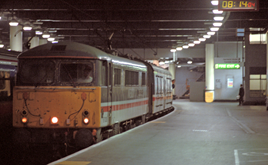Reporting for The Independent, Michael Williams (author of The Trains Now Departed) noted the confusion among staff as to whether the Sleeper “would change its identity from publicly to privately-owned … on the stroke of midnight or on arrival in Euston”.
Either way, it was clear that “there was little nostalgia among the 60 Standard and 35 First Class passengers aboard the 2355”. No anoraks, vacuum flasks, ABCs or ‘combis’ here. Most, as Williams noted, were “Edinburgh business people heading for work in London or tourists returning from the Easter weekend”.
And no one seemed to be bothered about the change in ownership. Indeed, many welcomed it, hoping for better service, better coffee, better sandwiches. The solitary note of regret came from Peter Simpson, Duty Manager at Waverley: “Wherever you went up and down the country, you were part of the railway family. Now, with privatisation, all that is gone.”
Through the night, through the Scottish and English countryside, the eight-coach train sped behind 87021 Robert the Bruce. A diversion through Birmingham meant the train was 22 minutes late arriving at Euston, but as the ‘87’ approached the stops there was one last vestige of the old BR left.
The Up might have been the last departure, but the Down Sleeper - the 2130 - was destined to be the last arrival. Waiting for the driver meant it had left Euston 24 minutes late. The Times called it “a fitting end to 50 years of jokes about tardiness”, and quoted an alleged enthusiast who said: “You’d have thought they’d have got their act together tonight.”
On board, many were unaware of the imminent change… and few cared when they found out. Yet they were involved in a small part of history - when the train pulled in to Fort William behind its thrumming Class 37 at around 1045 on April 1, it was all over for BR.
Well, almost! Welsby had one train operation left - Railfreight Distribution, which would enter the private sector that November, after the European Union had ratified its sale to EWS. His stewardship of non-operational railway land, the British Transport Police, the Railway Heritage Committee and a few other administrative tasks would continue a while longer.
For its part, The Times did point out the success of Inter-City and the HSTs, but also welcomed the new regulator “to step in where services are cancelled, fares structures labyrinthine, and through ticketing available to only the brave”. But the going wasn’t going to be easy in the new world - just as it hadn’t been in the old.
Thankfully, it wasn’t the end for the ‘Caledonian Sleeper’, which Serco now operates and which still goes to Aberdeen, Edinburgh, Glasgow, Inverness and Fort William. The ‘37s’ may have gone, but traction lovers can still thrill to the occasional roar of an ‘87’ under the wires, and still marvel at their reliability after 40-or-so years.
Traditionalists can also marvel that BR’s service pattern remains largely intact, such was the strength of its plan. They may lament the passing of the Mk 2 and Mk 3 stock next year, when Serco introduces its new Mk 5 fleet, but as these will feature en suite berths, we can rest assured that what novelist Andrew Martin described as “one of the last remaining outposts of British railway charisma” will be with us for many years to come.
This feature was published in RAIL 823 on 25th March 2017














Login to comment
Comments
FrankH - 13/06/2017 22:39
Used to read Peter Kellys articles in Rail Enthusiast, also a certain Nigel Harris used to contribute/edit. Both enjoyable reads with a twist of wit if I remember correctly.